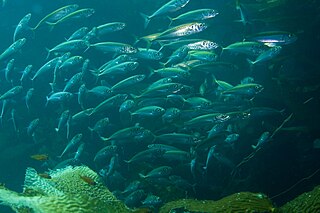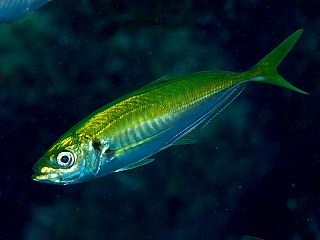
The Pacific jack mackerel, also known as the Californian jack mackerel or simply jack mackerel, is an abundant species of pelagic marine fish in the jack family, Carangidae. The species is distributed along the western coast of North America, ranging from Alaska in the north to the Gulf of California in the south, inhabiting both offshore and inshore environments. The Pacific jack mackerel is a moderately large fish, growing to a maximum recorded length of 81 cm, although commonly seen below 55 cm. It is very similar in appearance to other members of its genus, Trachurus, especially Trachurus murphyi, which was once thought to be a subspecies of T. symmetricus, and inhabits waters further south. Pacific jack mackerel travel in large schools, ranging up to 600 miles offshore and to depths of 400 m, generally moving through the upper part of the water column.

Jack mackerels or saurels are marine fish in the genus Trachurus of the family Carangidae. The name of the genus derives from the Greek words trachys ("rough") and oura ("tail"). Some species, such as T. murphyi, are harvested in purse seine nets, and overfishing has sometimes occurred.
The Peruvian martin is a species of bird in the family Hirundinidae. It is found in Peru and far norther Chile.
The Kolombangara white-eye or hermit white-eye is a species of bird in the family Zosteropidae. It is endemic to the Solomon Islands.
Ngairea murphyi is a species of small air-breathing land snail, a terrestrial pulmonate gastropod mollusk in the family Charopidae. This species is endemic to Australia.

The Chilean jack mackerel sometimes called the Inca scad, is a species of jack mackerel in the genus Trachurus of the family Carangidae. Since the 1970s, it has become one of the world's more important commercial fish species. High volumes have been harvested, but the fishery may now be in danger of collapsing.
Charaxes murphyi is a butterfly in the family Nymphalidae. It is found in northern Zambia and the south-eastern part of the Democratic Republic of the Congo. The habitat consists of riverine forests.
Listrocerum is a genus of longhorn beetles of the subfamily Lamiinae, containing the following species:
Listrocerum maynei is a species of beetle in the family Cerambycidae. It was described by Lepesme and Stephan von Breuning in 1956. It is known from the Democratic Republic of the Congo, Angola, Gabon, and the Central African Republic.
Listrocerum olseni is a species of beetle in the family Cerambycidae. It was described by Lepesme and Stephan von Breuning in 1956. It is known from Guinea.
Listrocerum quentini is a species of beetle in the family Cerambycidae. It was described by Lepesme and Stephan von Breuning in 1956. It is known from the Ivory Coast.
Listrocerum aeolis is a species of beetle in the family Cerambycidae. It was described by Thomson in 1857, originally under the genus Psathyrus. It is known from Mozambique, Ethiopia, Tanzania, Namibia, Kenya, Uganda, South Africa, and Zimbabwe.
Listrocerum apiceniger is a species of beetle in the family Cerambycidae. It was described by Stephan von Breuning in 1961. It is known from Cameroon.
Listrocerum aspericorne is a species of beetle in the family Cerambycidae. It was described by Chevrolat in 1855. It is known from Nigeria.
Listrocerum bicolor is a species of beetle in the family Cerambycidae. It was described by Lepesme in 1950, originally under the genus Combesius. It is known from Ghana, Sierra Leone, the Ivory Coast, the Central African Republic, and Togo.
Listrocerum fuscopicalis is a species of beetle in the family Cerambycidae. It was described by Stephan von Breuning in 1961. It is known from Cameroon.
Listrocerum joveri is a species of beetle in the family Cerambycidae. It was described by Quentin in 1951, originally under the genus Combesius. It is known from the Ivory Coast.
Listrocerum psathyroides is a species of beetle in the family Cerambycidae. It was described by Lepesme in 1950. It is known from the Ivory Coast.
Leuconitocris murphyi is a species of beetle in the family Cerambycidae. It was described by Jérôme Sudre and Pierre Téocchi in 2005. It is known from Malawi.

Zieria murphyi, commonly known as Murphy's zieria, is a plant in the citrus family Rutaceae and endemic to New South Wales. It is a slender shrub with simple, or three-part leaves and between three and nine white to pale pink flowers with four petals and four stamens arranged in the leaf axils. It usually grows in sheltered places in open forest, often at the base of cliffs.





